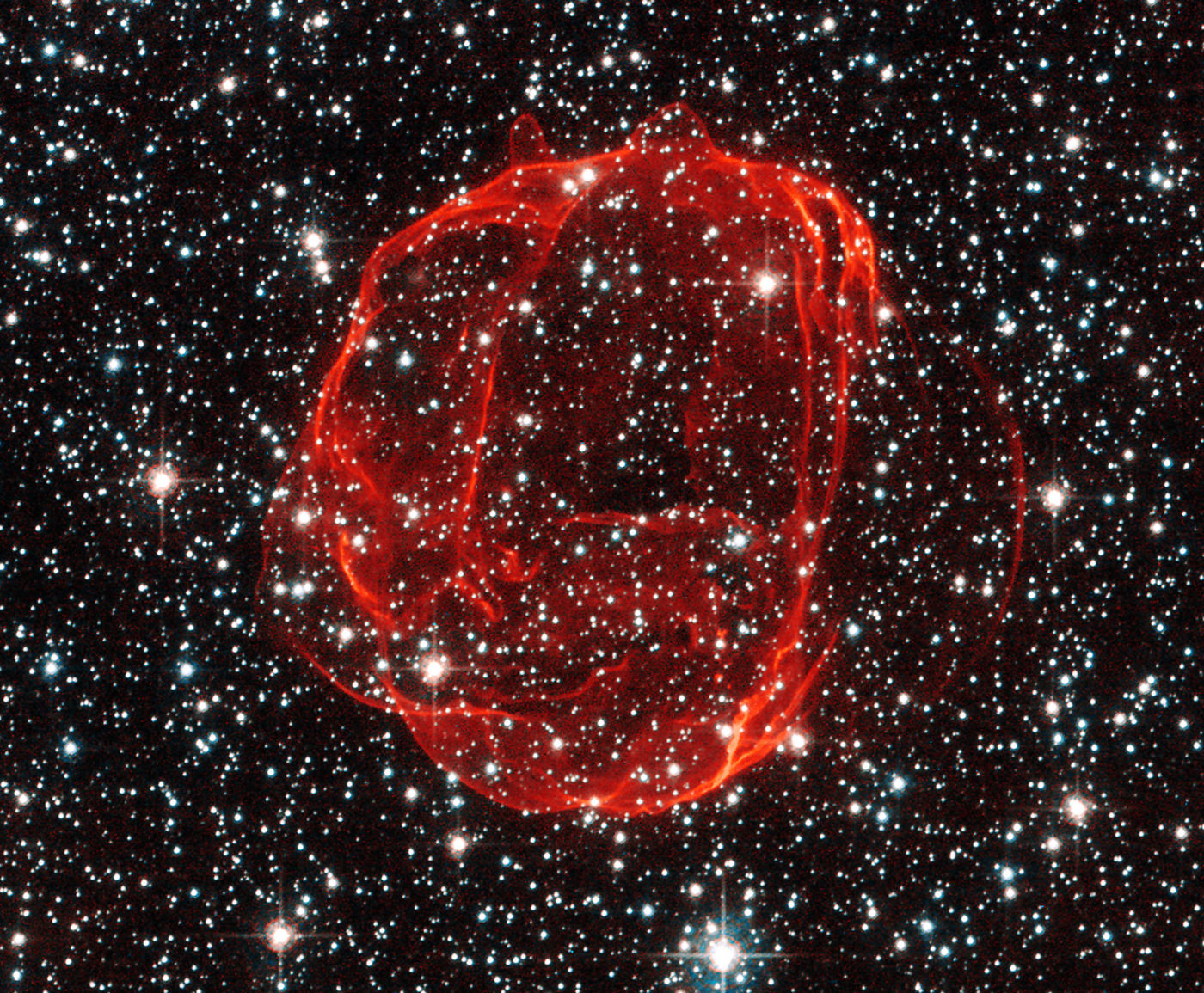Stars like our Sun can last for a very long time (in human terms, anyway!) somewhere in the neighborhood of 10-12 billion years. Already over 4.6 billion years old, the Sun is entering middle age and will keep on happily fusing hydrogen into helium for quite some time. But eventually even stars come to the end of their lives, and their deaths are some of the most powerful — and beautiful — events in the Universe.
The wispy, glowing red structures above are the remains of a white dwarf in the neighboring Large Magellanic Cloud 150,000 light-years away. Supernova remnant SNR 0519 was created about 600 years ago (by our time) when a star like the Sun, in the final stages of its life, gathered enough material from a companion to reach a critical mass and then explode, casting its outer layers far out into space to create the cosmic rose we see today.
As the hydrogen material from the star plows outwards through interstellar space it becomes ionized, glowing bright red.
SNR 0519 is the result of a Type Ia supernova, which are the result of one white dwarf within a binary pair drawing material onto itself from the other until it undergoes a core-collapse and blows apart violently. The binary pair can be two white dwarfs or a white dwarf and another type of star, such as a red giant, but at least one white dwarf is thought to always be the progenitor.
Read more: A New Species of Type Ia Supernova?
A recent search into the heart of the remnant found no surviving post-main sequence stars, suggesting that SNR 0519 was created by two white dwarfs rather than a mismatched pair. Both stars were likely destroyed in the explosion, as any non-degenerate partner would have remained.
This image was chosen as ESA/Hubble’s Picture of the Week. See the full-sized version here.
Credit: ESA/Hubble & NASA. Acknowledgement: Claude Cornen


Incredible how a ‘star seeds’ everything we know in the universe. 40yrs. studying our star & yet I learn something new on a daily basis. Less then one-tenth of <1% does the human race knowledge of this vast universe's contents of the hows & whys. It is beyond comprehension at this point in earth-time.
Incredible isn’t it. Like human beings have only used <1% of our brains. Goes hand & hand I guess.
Yes, <1% of mans brain used & the approximately more or less w/our universe. Good point. ..take care.
Exactly. Take care also.
That is an urban myth. We use a great deal of our brain, the old saying BTW was 10% not 1.
The science paper(s) written at places such as Tuffs-N.E-Med Center in Boston. Have their own %’s. We all have read different papers w/different opinions. The %’s of the use of the human brain is just a approxm. figure(s) a Dr or scientists in the field arrives at. It is NOT my area of study/work. I am just quoting from yrs of research from various medical data. Just proves you can’t always believe what we read. Using the averages is the best I believe. ..take care.
Yes, I have heard of the wide spread %. From <1% to as much as 20%. The % will vary wildly..
What? No relatively nearby speedy neutron star or magnetar? Look again? If the progenitor star(s) exploded in a ‘lopsided’ fashion, then the stellar remnant(s) may have been kicked out of the system at high speed? How fast? The fastest moving star we’ve seen is traveling at about 1,800 kilometers per second, or 4 million miles per
hour. There are 8,760 hours in a year, so the remnant may have moved some 35,040,000,000 miles each year. Multiply that times 600 years and you get 21,024,000,000,000 miles. Light travels 5,878,499,817 miles in a year. Divide the two and you get approx. 3.58 light years… That COULD be how far away the progenitor may be now? (Our time) And yet… there may be even faster moving stars? Any truly comprehensive search for the progenitor would then have to scan an area at least that large….
The article speaks of a type Ia SNe. Those are expected to completely unbind in the explosion, leaving no neutron star remnant nor black hole.
That COULD be how far away the progenitor may be now? (Our time) And
yet… there may be even faster moving stars? Any truly comprehensive
search for the progenitor would then have to scan an area with at least
that radius….
“the remains of a white dwarf in the neighboring Large Magellanic Cloud ”
No, not the remains of a white dwarf, white dwarfs are remains of stars and they are very quiet indeed. This nebula is the remains of a sun-like star as mentioned later in the article.
According to the ESA/Hubble release: “There are several types of supernova, but for SNR 0519 the star that exploded is known to have been a white dwarf star — a Sun-like star in the final stages of its life.”
what an amazing picture..It’s time for a new hubble telescope!! Wonder what other amazing images lie out there!!